Ryan Hall's Blog, page 224
August 22, 2016
10 Amazing Running Moments at the Rio Olympics
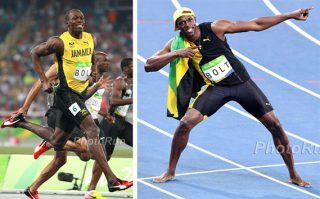
The Rio Olympics are done and gone, but the legacy of the XXXI Olympiad will live on forever by way of memorable highlights, record-setting performances and legendary athletes. Here are 10 of the best running moments from Rio de Janeiro that should never be forgotten.
PHOTOS: How the U.S. Track & Field Team Shined in Rio
Photo Gallery
1 of {count}
Back to Start
View Larger Image
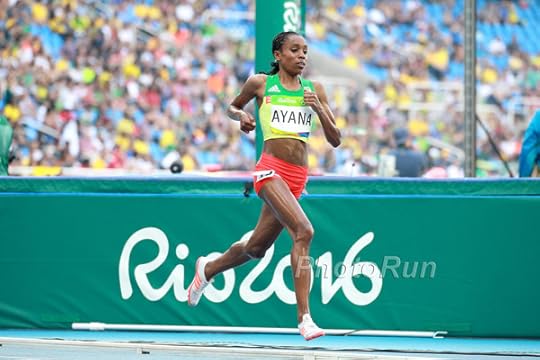
Almaz Ayana's Out-of-This-World 10,000m Victory
Ethiopia's Almaz Ayana has been running out of this world for the past two years, but she still stunned everyone with her world-record performance in the women's 10,000m. She not only dominated perhaps the best field of runners ever assembled on the world's biggest stage, but she also broke Wang Junxia's 1993 world record in 29:17.45 by running ridiculous 5K splits of 14:47.10 and 14:30.35. Doping accusations quickly followed—which might be understandable given Ethiopia's insufficient ouf-of-competition testing—but she stands by her effort as being pure. “My doping is my training and my doping is Jesus," she said. "Nothing otherwise — I am crystal clear.” Photo: PhotoRun.net
View Larger Image

Wayde van Niekerk's Stunning World Record
Wayde van Niekerk turned in perhaps the singular most impressive effort in the Rio Olympics. The 24-year-old South African shattered Michael Johnson's 19-year-old record by running an unthinkable 43.03 for the one-lap race. And he did it while running out of lane 8! He's no fluke, given that he won the event at the world championships last summer in Beijing and was already the only man to have run under 10 seconds in the 100, under 20 seconds in the 200 and under 44 seconds in the 400. Could he become the first man to break 43 seconds in the 400? It sure seems likely. What makes this story even better is the fact that he is coached by his 74-year-old great-grandmother Ans Botha. Photo: PhotoRun.net
View Larger Image
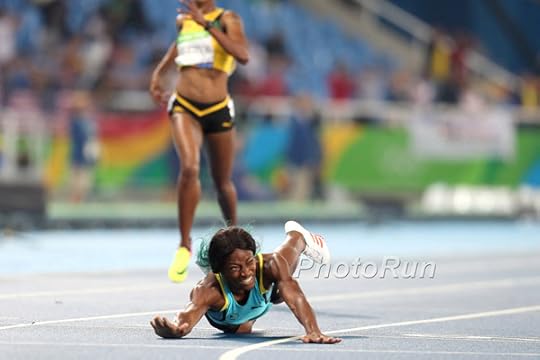
Shaunae Miller's Victorious Dive in the 400m
Shaunae Miller already owned the fastest time in the world in the 400m when the Olympics started, so it was no surprise to anyone that she was leading the race down the homestretch. But even she knew that American Allyson Felix would be closing hard and it would be a close finish. The 22-year-old Bahamian sprinter and University of Georgia athlete gave it everything she had, every last ounce and then she gave more. As she approached the line with Felix in her peripheral vision, Miller fell forward and dove across the finish line to secure a victory in a personal best time of 49.44 and a .07 margin over runner-up Felix. While there was some outcry from Felix fans and some uninformed reporters, Miller's dive earned major respect from the track and field community as a amazing example of leaving it all out there on the track. Photo: PhotoRun.net
View Larger Image
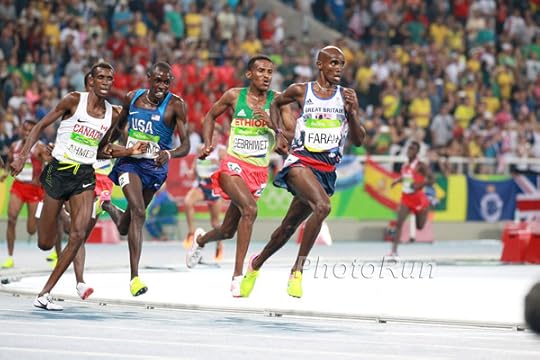
Mo Farah's "Double Double"
Love him or loathe him, Mo Farah is still the king of the 5,000m and 10,000m. Farah repeated his golden double in those events from the London Olympics. He recovered from a mid-race fall in the 10,000 to win in 27:05.17 and came back a week later to out-duel Ethiopia's Hagos Gebrhiwet and run away with the 5,000 in 13:03.30. By repeating in both events, he joins legendary Finnish runner Lasse Viren (1972, 1976) as the only runners to pull off the "double double" feat in the 5,000m and 10,000m. Photo: PhotoRun.net
View Larger Image
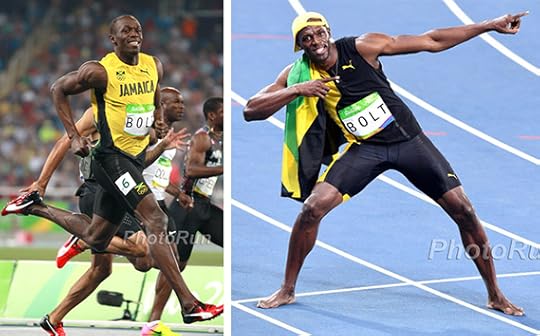
Usain Bolt's Grand Farewell
If Farah's "double double" was impressive—and it was—then Usain Bolt's "triple triple" borders on being the feat of an immortal. The 29-year-old Jamaican legend won gold in the 100m, 200m and 4x100m relay for the third straight Olympics, and, of course, he did it with his playful bravado. While some skeptics thought he might be losing a step, Bolt looked entirely untouchable in winning the 100m in 9.81, taking the 200m in 19.78 and anchoring the 4x100 in a world-leading 37.27. There have been many outlandishly fast sprinters in the past two decades, but what makes Bolt so extraordinary is that he hasn't lost a single 100m or 200m championship race since 2007 (except for a false start in the 100m at the 2011 world championships) and also because every other top-tier sprinter has been busted for doping at least once during that time and he hasn't. Photos: PhotoRun.net
The Olympic spirit was on full display during the second heat of the women's 5,000m run. When New Zealand runner Nikki Hamblin tripped and fell to the track, American Abbey D'Agostino tripped and fell, tearing the ACL in her right knee in the process. As Hamblin lay there wondering what had happened, she felt D'Agostino's hand on her shoulder. "Get up, get up! We have to finish!'' D'Agostino famously told her. "This is the Olympic Games. We have to finish this." They got up and started hobbling together, but then D'Agostino fell on her weak knee and Hamblin helped her up. They struggled to finish the final four laps and were granted a spot in the final, but D'Agostino was unable to run because of her injury. It will be a long road back for D'Agostino—a 24-year-old native of Topsfield, Mass., who won seven NCAA titles at Dartmouth—but she's already proven she has a heart of gold. Photos: PhotoRun.net
View Larger Image
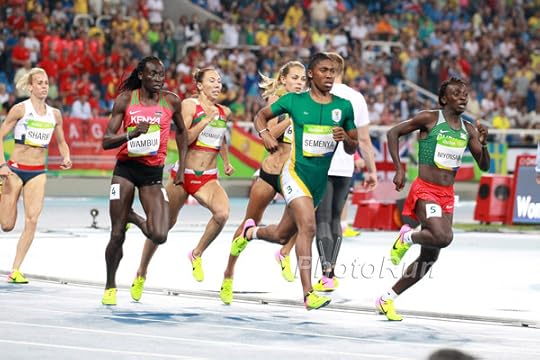
Caster Semenya's Dominant 800m Win
After years of being caught in a controversy surrounding her gender identity, Caster Semenya returned to the top step of the podium for the first time in seven years by winning gold in the women's 800m race in resounding fashion. The 25-year-old South African won the race in 1:55.28, a new personal best time and her first global championship since her 2009 world championship victory in 1:55.45. In the interim, Semenya was subjected to drug testing and gender testing—not to mention public humiliation—as the result of a few track officials questioning her performances. Briefly kept out of competition in 2009 and part of 2010, she was determined to have hyperandrogenism, or high natural levels of testosterone, but eventually allowed to compete again in mid-2010. Although she won silver medals in the 2011 world championships and 2012 Olympics (behind convicted Russian doper Mariya Savinova), Semenya didn't return to dominance until this year. Photo: PhotoRun.net
View Larger Image
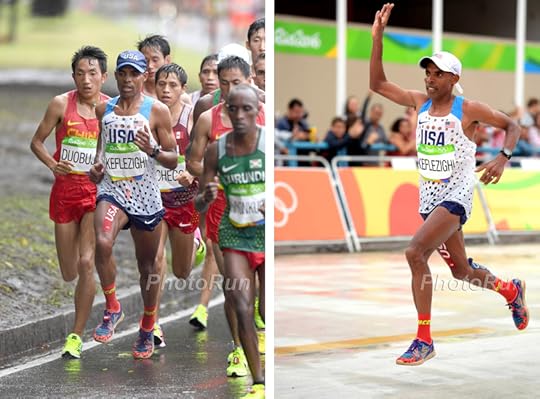
Meb Keflezighi's Final Olympics and Graceful Finish
The 2016 Olympics marked a farewell of sorts for Meb Keflezighi. The seemingly ageless American runner ran in his fourth and likely final Olympics at age 41. Although he struggled in the marathon—stopping several times during the first half, then slipping just before he crossed the finish line—he still completed the race with class and respect in 33rd place (2:16 :46). When he inadvertently slipped just before the finish line, he handled it with grace and humor, kissing the ground and then doing a few pushups before rising with a smile on his face. Meb will be remembered as one of the all-time greats, both becuase he's always been a fierce competitor and a true gentleman. Photos: PhotoRun.net
View Larger Image
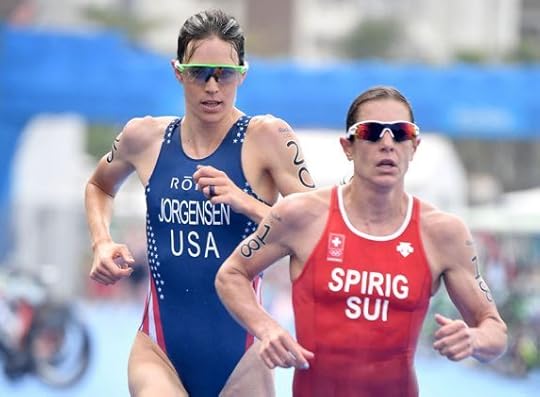
Gwen Jorgensen's Victory in the Women's Triathlon
One of the greatest runs of the Olympics came in the close of the women's triathlon. At the majority of ITU races, American Gwen Jorgensen is known to break away from the field and lead a big chunk of the 10K. But in the Aug. 19 women's triathlon she had the gritty Nicola Spirig of Switzerland right on her shoulder from the moment they left T2. “When I was watching the two of them duke it out in the front, I could see that they were running together for a long time before Gwen surged away,” says Rio bronze medalist Vicky Holland. “It’s become almost inevitable—we’ve seen it in so many races. And when Gwen is gone, it’s very hard to get her back again.” With 2K to go, Jorgensen initialized her famous surge, and Spirig couldn’t match her pace. Jorgensen ran away with the race after clocking a 34:09 10K split—roughly 5:30-mile pace. “I was very well prepared,” Spirig says, “And I haven’t seen anyone running with her longer than I did today. I knew she was running really, really well, and I tried everything to beat her, but she was just too good in the moment.” Photo: Delly Carr/Triathlon.org/Courtesy of Triathlete Magazine
View Larger Image
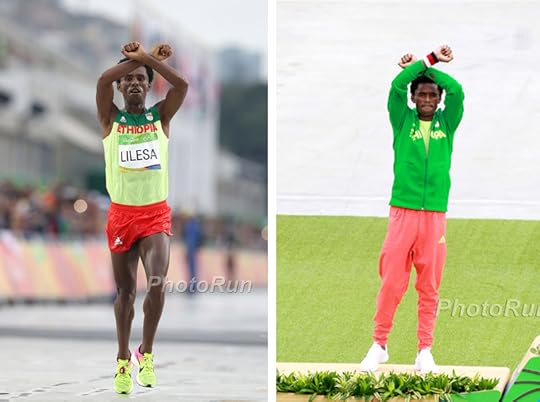
Feyisa Lilesa's Thoughful Political Protest
Feyisa Lilesa ran a courageous race to earn the silver medal in the Olympic marathon, hanging on eventual champion Eliud Kipchoge of Kenya until the 23rd mile and finishing in 2:09:54. But that was the second most courageous thing he did that day. As he was approaching the finish line and again at the medal ceremony for the race, Lilesa put his arms over his head to create an "X" a sign of solidarity for the Oromo people—his native group and the largest ethnic group in Ethiopia—who have been marginalized for decades with tensions rising recently as government-promoted development has taken over Oromo farmland and resulted in hundreds of deaths. "I really think that I would be killed," he said—or imprisoned. Some of his family members are already in prison, he said, and he worries about the safety of his wife and two children. Lilesa said he may stay in Brazil or go to Kenya or the United States, depending on whether he can obtain a visa. Photos: PhotoRun.net

More Galleries
The post 10 Amazing Running Moments at the Rio Olympics appeared first on Competitor.com.
U.S. Track & Field Storms to Huge Success at the Rio Olympics

The U.S. track and field team absolutely crushed it in the Olympics, racking up medals, setting records and turning in unprecedented results in Rio. Team USA collected 32 medals by running, throwing and jumping, the most in any Olympics since 1984 and the most in a non-boycotted Olympics since 1932. Here’s a glance how the Americans shined.
RELATED: The 10 Most Amazing Running Moments at the Rio Olympics
Photo Gallery
1 of {count}
Back to Start
View Larger Image

2016 Olympic Games
Molly Huddle placed sixth in the 10,000m run in a new American record of 30:13.17. It was the fastest 10,000m race in history, thanks to a new world record from Ethiopian Almaz Ayana (29:17.45) at the front of the pack. Photo: PhotoRun.net
View Larger Image
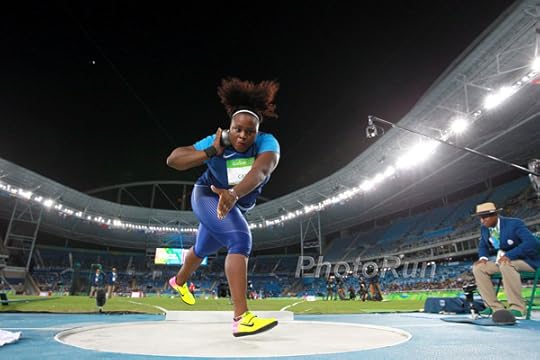
2016 Olympic Games
Michelle Carter was the first American to medal in track & field, taking the shot put competition with a new U.S. record of 20.63 meters—or 67 feet, 8 inches. Photo: PhotoRun.net
View Larger Image
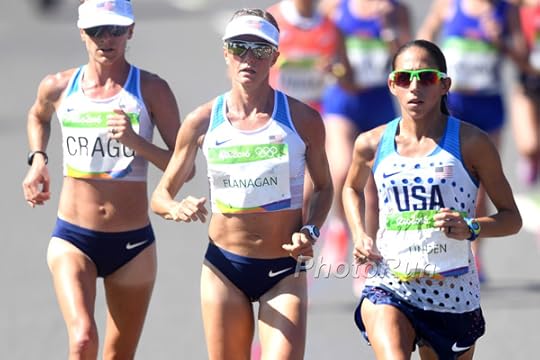
2016 Olympic Games
Although they didn't earn medals in the women's marathon, the trio of Shalane Flanagan (6th, 2:25:26), Desi Linden (7th, 2:26:08) and Amy Cragg (9th, 2:28:25) had the strongest showing of any country. Each runner battled with the lead group deep into the race and hung on to finish among the top 10. Photo: PhotoRun.net
View Larger Image
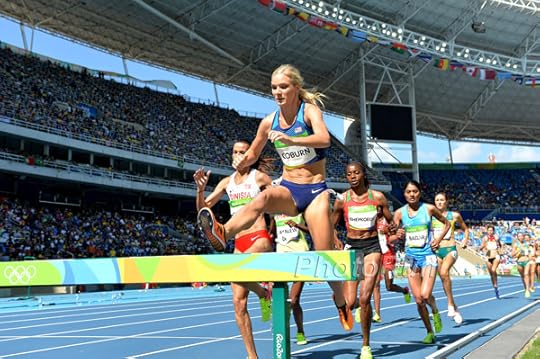
2016 Olympic Games
Emma Coburn was the first American distance runner to stand on the podium, as she earned the bronze medal in the 3,000m steeplechase. In doing so, Coburn became the first American woman to medal in the event since its inception in the Olympics in 2004. Photo: PhotoRun.net
View Larger Image
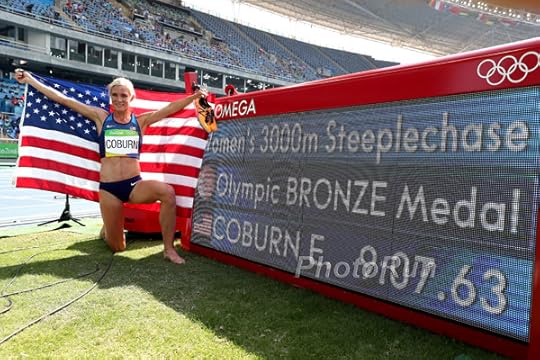
2016 Olympic Games
In finishing third in the steeplechase, Coburn lowered her own American record in the event to 9:07.63. Photo: PhotoRun.net
View Larger Image

2016 Olympic Games
Coburn also caused a bit of a media frenzy by smartly holding her New Balacne spikes during post-race photo sessions. New Balance is not an official sponsor and controversial Rule 40 prohibits athletes of mentioning brands in interviews or any type of social media. Photo: PhotoRun.net
View Larger Image
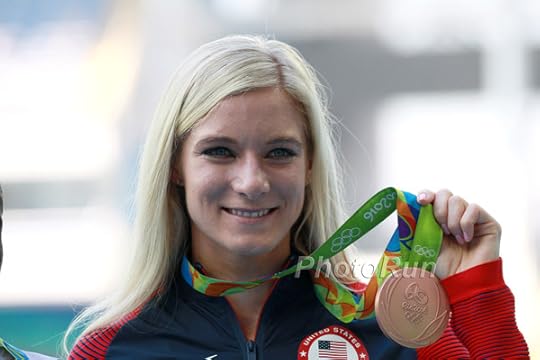
2016 Olympic Games
The bronze medal was the first international medal for Coburn, who placed 12th in the 2012 Olympics and fifth in the 2015 world championships in the steeplechase. She also famously borrowed a hair tie from Evan Jager, who went on to earn the silver medal in the men's 3,000m steeplechase. Photo: PhotoRun.net
View Larger Image
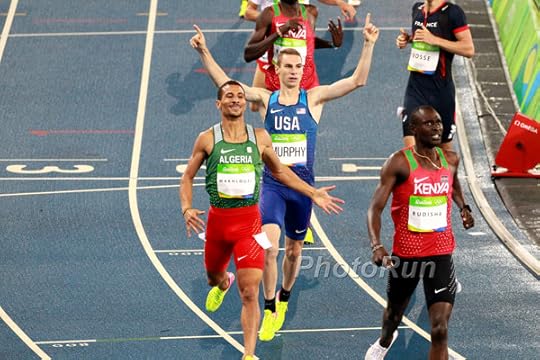
2016 Olympic Games
Clayton Murphy continued his strong running with a bronze medal in the 800m, running the third-fastest time in U.S. history (1:42.93). Murphy, the 2016 NCAA 1,500-meter runner and U.S. Olympic Trials 800m champion, was the first American man to medal in the event since 1992. Photo: PhotoRun.net
View Larger Image

2016 Olympic Games
Running in her third Olympics, Jenny Simpson won the bronze in the women's 1,500m run. Photo: PhotoRun.net
View Larger Image
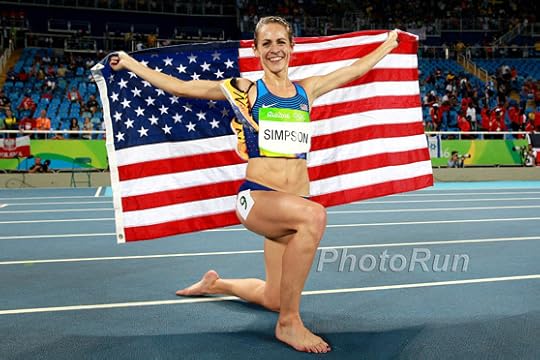
2016 Olympic Games
Simpson, who already owns a gold and silver medal from the world championships, became the first American woman to win an Olympic medal in the 1,500m. And she followed Coburn's lead by getting New Balance plenty of love in post-race photos. Photo: PhotoRun.net
View Larger Image
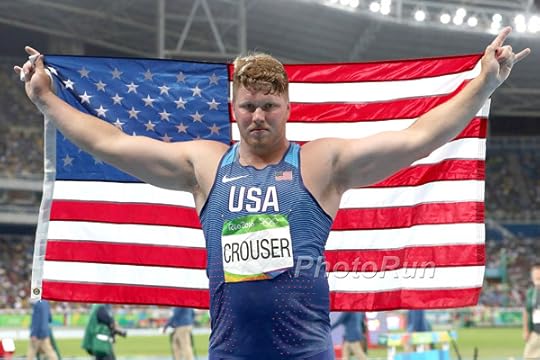
Crouser_RyanFL-Rio16
Ryan Crouser was perhaps the top performer on the U.S. track team. He won the shot put gold medal with an Olympic record throw of 22.52 meters. Photo: PhotoRun.net
View Larger Image

2016 Olympic Games
Tori Bowie came home with a lot of hardware for the U.S., earning a silver medal in the 100m, a bronze medal in the 200m and a gold medal in the 4x100m relay. Photo: PhotoRun.net
View Larger Image

2016 Olympic Games
Bowie was clocked in 10.83 in the 100m, just off her PR of 10.78. Photo: PhotoRun.net
View Larger Image
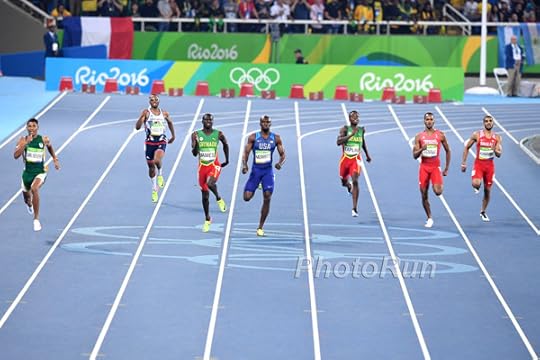
2016 Olympic Games
In the men's 400, LaShawn Merritt (center) ran a season-best 43.85 but it was only good enough to earn him the bronze medal. The 2008 Olympic champion could only watch from behind as South Africa's Wade Van Niekerk set a new world record of 43:03 en route to the gold medal. Photo: PhotoRun.net
View Larger Image

2016 Olympic Games
Merritt also placed sixth in the 200m, but then he came back to help the U.S. win the 4x400m relay (2:57.30) and avenge a 2012 loss to the team from the Bahamas. Photo: PhotoRun.net
View Larger Image
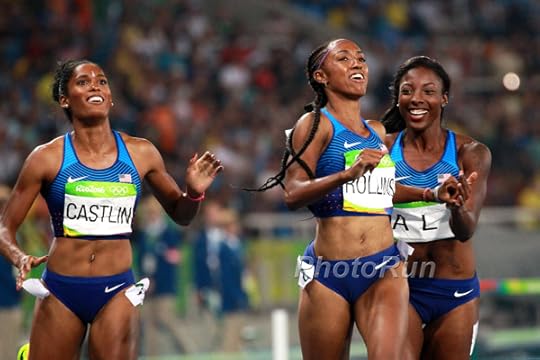
2016 Olympic Games
The U.S. swept the top three spots in the women's 100m hurdles. Brianna Collins won the race in 12.48 seconds, followed by teammates Nia Ali (12.59) and Kristi Castlin (12.61). Photo: PhotoRun.net
View Larger Image

2016 Olympic Games
While getting the silver medal in the 400m dash was a disappointment, Allyson Felix stiill became the most decorated U.S. female track athlete in history with 9 total medals since 2004. In addition to her close second in the 400, she also ran legs of the gold-medal-winning 4x100m and 4x400m relays. Photo: PhotoRun.net
View Larger Image

2016 Olympic Games
Justin Gatlin gained more notoriety for twice being suspended for doping earlier in this career, but he also finished second in the 100-meter dash to Usain Bolt in 9.89 seconds. Photo: PhotoRun.net
View Larger Image
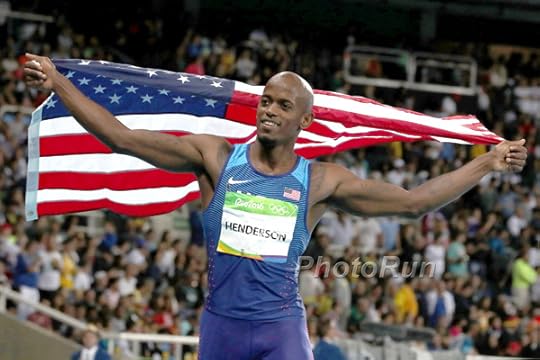
2016 Olympic Games
Jeffrey Henderson won the long jump competition by 1 cm, jumping 8.38 meters—or 27 feet, 5.6 inches. Photo: PhotoRun.net
View Larger Image
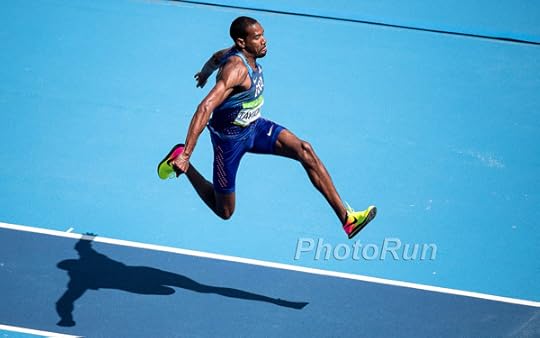
2016 Olympic Games
Christian Taylor successfully repeated as triple jump champion ...
View Larger Image
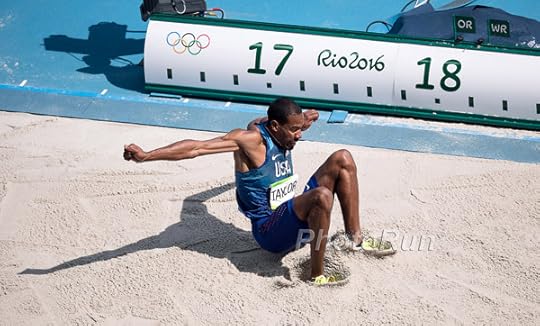
2016 Olympic Games
... taking the gold medal with a winning jump of 17.86 meters—or 58 feet, 7 inches.
View Larger Image
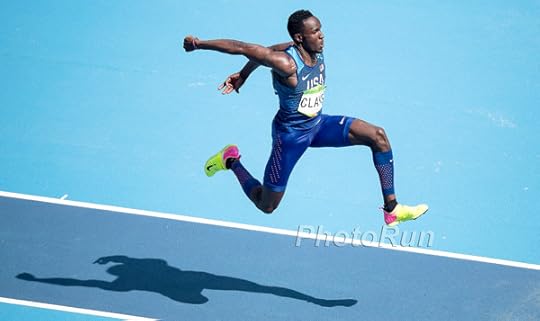
2016 Olympic Games
Meanwhile, Willie Claye placed a close second in the triple jump with a best leap of 17.76 meters—or 58 feet, 3 inches. Photo: PhotoRun.net
View Larger Image
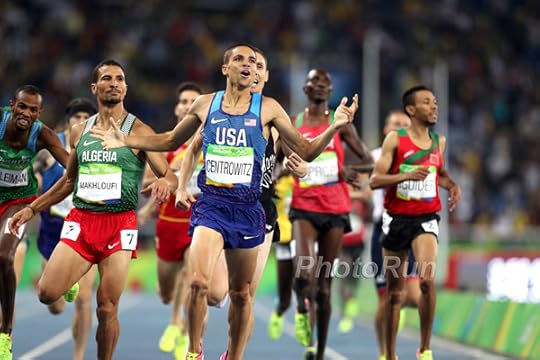
2016 Olympic Games
Matthew Centrowitz Jr. turned in a golden performance in the men's 1,500m run. He won the tactical race in a pedestrian 3:50.00, becoming the first American winner in that event since 1908. Photo: PhotoRun.net
View Larger Image
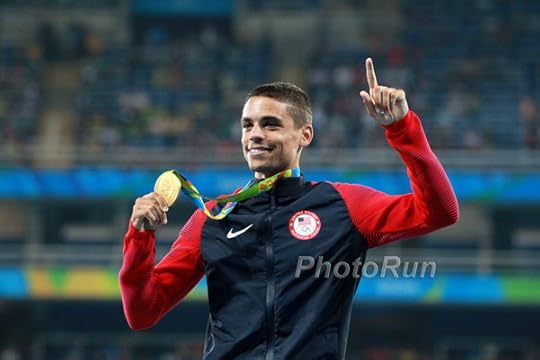
2016 Olympic Games
Centrowitz, the son of two-time U.S. Olympian Matt Centrowitz, was hoping to make amends for finishing fourth and narrowly missing a medal in the 2012 Olympics. Suffice to say he did so much more than that. Photo: PhotoRun.net
View Larger Image
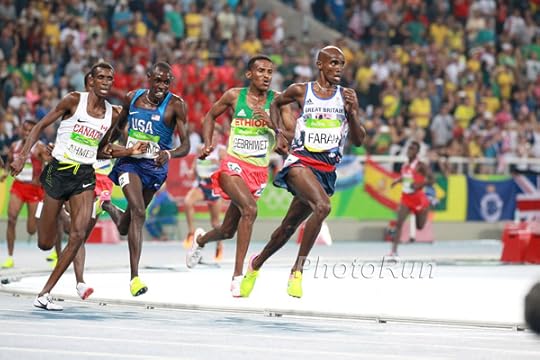
2016 Olympic Games
In the men's 5,000m, Paul Chelimo battled hard around the last turn to get in position for a strong finishing kick in pursuit of eventual winner Mo Farah. While Farah successfully defended his gold medal from 2012, Chelimo, a Kenyan-born American in his first Olympics, earned the silver medal by finishing in 13:03.90, just .60 seconds behind Farah. Photo: PhotoRun.net
View Larger Image

2016 Olympic Games
Chelimo momentarily lost his medal when he was ruled to have stepped on the inside of the track. But an appeal overturned the protest result and Chelimo was reinstated, thus earning the first U.S. medal in the event since 1964. (Had Chelimo lost the appeal, American Bernard Lagat, the fourth-place finisher, would have taken the bronze.) Photo: PhotoRun.net
View Larger Image
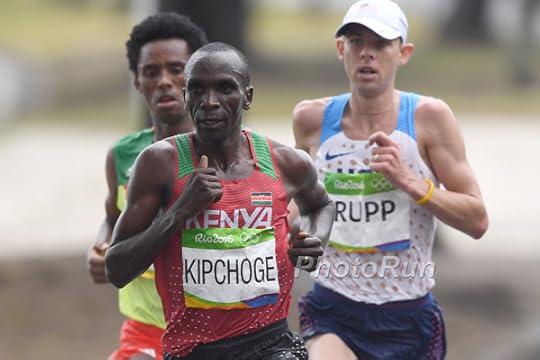
2016 Olympic Games
In the men's marathon on Aug. 21,Galen Rupp stuck with eventual winner Eliud Kipchoge of Kenyan and eventual runner-up Feyisa Lilesa of Ethiopia through mile 21 and hung on for the bronze medal. Photo: PhotoRun.net
View Larger Image
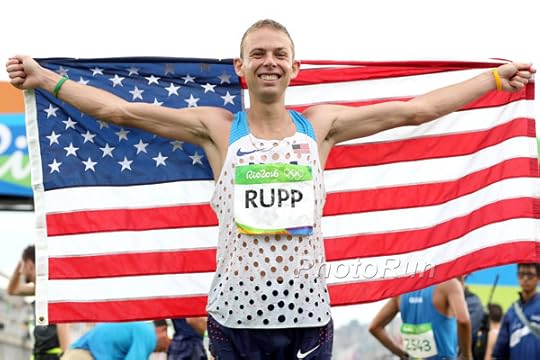
2016 Olympic Games
Running in just his second marathon, Galen Rupp finished third and lowered his PR to 2:10:05 and earned the first U.S. medal in the men's marathon since 2004. Rupp also placed fifth in the 10,000m run on Aug. 13. Photo: PhotoRun.net
View Larger Image
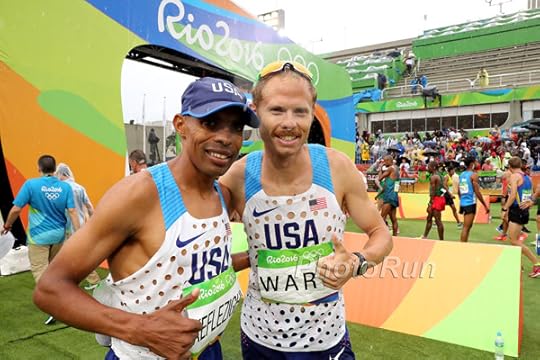
2016 Olympic Games
While Galen Rupp earned a lot of attention for earning the bronze medal in the men's marathon, Jared Ward (6th, 2:11:30) and Meb Keflezighi (33rd, 2:16:46) also turned in strong performances. It was the first Olympic effort for the 27-year-old Ward, while it was the fourth Olympics for the 41-year-old Keflezighi. Photo: PhotoRun.net
View Larger Image
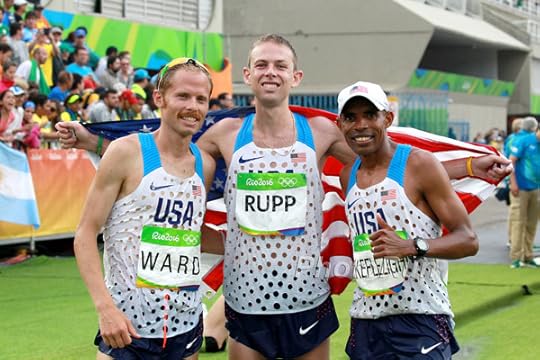
2016 Olympic Games
Ward, Rupp and Keflezighi all ran strong races and collectively combined for one of the best Olympic showings ever by the U.S. Photo: PhotoRun.net

More Galleries
The post U.S. Track & Field Storms to Huge Success at the Rio Olympics appeared first on Competitor.com.
August 21, 2016
New & Improved: Changes Made for Oct. 8 Synchrony Financial Rock ‘n’ Roll Brooklyn Half Marathon

The 2016 Rock 'n' Roll Brooklyn Half Marathon will have a new start line in front of the Brooklyn Art Museum. Photo: Ryan Bethke
On any given day, running through Brooklyn can be a real treat. The famous New York City borough is full of incredible sights—from the gorgeous foliage throughout the borough’s Prospect Park to the stunning architectural gems in its brownstones that line its iconic streets. But on Oct. 8, running through Brooklyn will be better than ever with the Synchrony Financial Rock ‘n’ Roll Brooklyn Half Marathon, thanks to a new course and several other key improvements to the overall racing experience.
VIDEO: Watch a highlight video of the Synchrony Financial Rock ‘n’ Roll Brooklyn Half Marathon
Given some of the challenges participants experienced at the start last year, organizers immediately began working on changes that were needed to make this event even better, including adjustments to the pre-race experience before the starting gun sounds. The race’s start line will now be conveniently located outside the iconic Brooklyn Art Museum, and corrals will line up on Eastern Parkway, avoiding any congestion around the Grand Army Plaza area. Additional security screening checkpoint entrances have been added for a quicker and easier entrance into the corrals. And to minimize the stress of finding a bathroom before the start, additional porta pottys have been added in the start line village. Lastly, the gear check area has been moved closer to the start line on Flatbush Avenue near the library, for easy access to drop off items you’ll need post race.
Besides these key logistical improvements, the race has also undergone a slight course facelift. Course operations director Ted Metellus has been front and center with the new design and says the impetus for the change was to make the experience a better one for participants and their loved ones.
“We wanted to simplify the security screening process to the corrals at the start,” said Metellus, adding that the change was a win-win for everyone. “The NYPD and the Office of Special Events supported us, because the new course provides participants easy access to the start and gear drop.”
The key changes focus on the start and opening miles. Runners will line up next to the museum and then head out along the city’s tree-lined Eastern Parkway and then back on Kingston Avenue in the first two miles. Between the second and third mile, participants will make a left onto Washington Avenue and get some great visuals of the fall foliage in Prospect Park on their right.
Elevation is everyone’s friend at this point in the race. Runners will experience some nice descents at the start and right after the 2-mile mark (100-plus feet). By mile 3, Metellus says runners will be back on the 2015 course along Ocean Avenue filled with trademark NYC architecture of historic brownstones and beautiful apartment buildings. Elevation-wise, miles 4 to 8 are all about cruising on flat pavement and checking out the best parts of Brooklyn while jamming to entertainment along the sidelines.
The course begins to get challenging from mile 10 as runners turn into beautiful Prospect Park. A steep uphill awaits at mile 11, so runners should be sure to save “gas in the tank” for this final stretch, but the views of the park and the roar of the crowds near the finish line should help. The course flattens out in the final mile as a stunning finish line awaits everyone in the heart of one of New York City’s most charming green spaces.
“The Rock ‘n’ Roll Brooklyn Half Marathon course offers a little bit of everything in an urban course,” Metellus said. “It’s got its climbs and its descents. It has its straightaways and its turns. But during it all, you will be running down tree-lined streets and through a beautiful park.”
In addition to all the improvements this year, there are also a lot of great things from last year’s Rock ‘n’ Roll Brooklyn Half Marathon that will remain the same. This race is one of the only running events to exclusively shut down major streets and landmarks in New York City’s most populous borough, which means runners will get an intimate and exclusive experience as they bound through parts of the Big Apple.
More good news: even more entertainment and cheer squads will be along the course than last year. So if you’re considering Brooklyn, don’t hesitate.
Register: 2016 Synchrony Financial Rock ‘n’ Roll Brooklyn Half Marathon
The post New & Improved: Changes Made for Oct. 8 Synchrony Financial Rock ‘n’ Roll Brooklyn Half Marathon appeared first on Competitor.com.
August 19, 2016
Running Deep in the Heart of Ethiopia’s Rift Valley
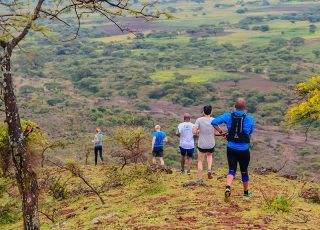
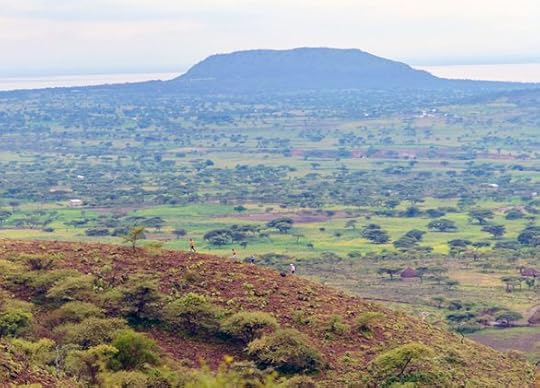
Located in the heart of Ethiopia’s ancient Rift Valley, along the shores of lakes Abijata and Shalla, the international Ethiotrail trail race is held every August. Set in the wild and beautiful Abijatta-Shalla Lakes National Park, Ethiotrail offers 21K and 12K distances that wind through Oromo tribal villages, thick Acacia forests, up and over ancient volcanoes and along the shores of Lake Shalla. For the third year, a large field of Ethiopian and international runners from more than 20 countries raced over the landscape in a celebration of trail racing, park conservation and cultural honoring.
August is the rainy season in Ethiopia, and so it was no surprise that the Aug. 7 race was true to its trail running roots, with small ravine crossings, off-trail sections climbing rocky volcanoes and winding two-track sections that took runners through Oromo tribal villages. Many of the local Oromo people came out to cheer on the runners, watching as everyone had a chance to win the substantial prize purse of 10,000 Birr (roughly equivalent to one month’s pay in Ethiopia). In the end, despite the rough nature of the course, the winning Ethiopian runners were able to cover the course in 1:16 for the men and 1:28 for the women.
Get a glimpse of the splendors of the Ethiotrail races through the images and captions below.
Photo Gallery
1 of {count}
Back to Start
View Larger Image
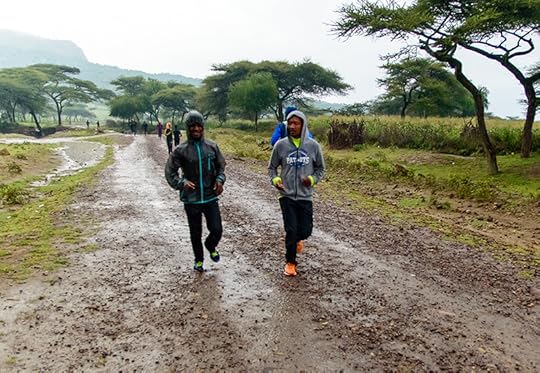
Ethiopia's Ethiotrail Races
After a night of rain, race-day conditions were wet and sloppy in places—including a washed out section of the course. However, that was to be expected during the rainy season in Ethiopia, which runs from June through September. Photo: Peter N. Jones
View Larger Image

Ethiopia's Ethiotrail Races
Despite the rain, spirits were high among runners, as there are few official trail races in Ethiopia. Photo: Peter N. Jones
View Larger Image

Ethiopia's Ethiotrail Races
In Ethiopia, races are taken very seriously among the local runners. For many, it is a way to gain recognition – and the substantial prize purse of 10,000 Birr (roughly equivalent too one month's pay) attracted some top athletes to the race. Photo: Peter N. Jones
View Larger Image
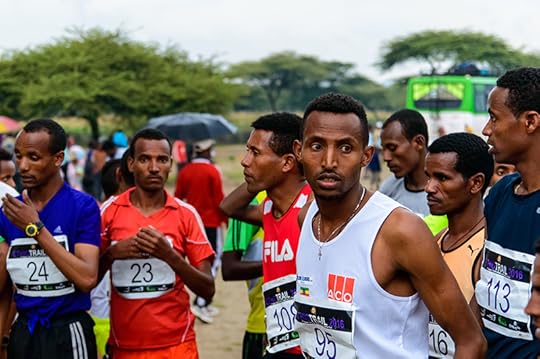
Ethiopia's Ethiotrail Races
Several of the Ethiopian runners in the races had personal bests for the half marathon under 1:10. Here Fiqru Leoulseged (#95), running for Club Elmi Olindo, contemplated the competition and prepared himself for the race. Photo: Peter N. Jones
View Larger Image
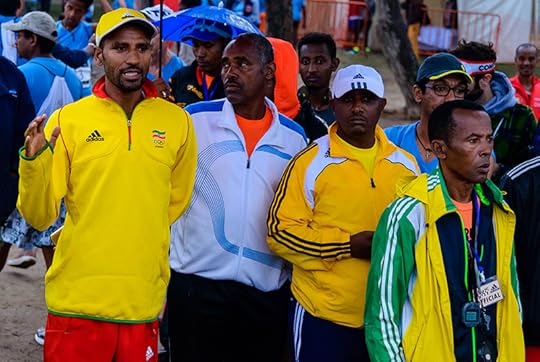
Ethiopia's Ethiotrail Races
The running community in Ethiopia is very strong, and elite's such as 2010 New York marathon winner Gebre Gebremariam (on the left in the yellow track suit) play important roles in encouraging running's continued growth by attending and officiating races. Photo: Peter N. Jones
View Larger Image
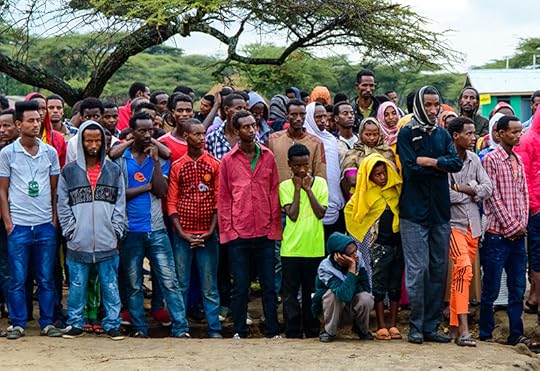
Ethiopia's Ethiotrail Races
Hundreds of local villagers from throughout the area made the trek to watch the race and cheer on the runners. Photo: Peter N. Jones
View Larger Image
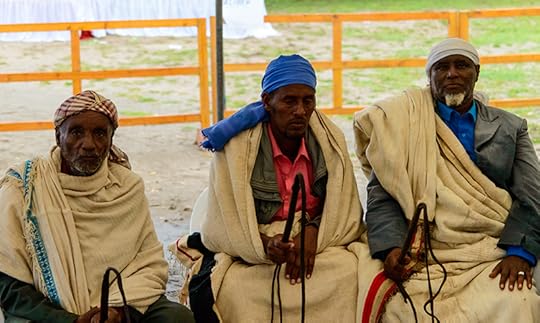
Ethiopia's Ethiotrail Races
Oromo tribal chiefs from the local villages attended the race, giving their blessing to the event which works to help conservation in the national park and to provide employment to the local villagers. Photo: Peter N. Jones
View Larger Image

Ethiopia's Ethiotrail Races
Not everyone was there to race, and many runners from throughout Ethiopia and around the world came to have the opportunity to run through one of the oldest landscapes in the world—Ethiopia's ancient Rift Valley. Photo: Peter N. Jones
View Larger Image

Ethiopia's Ethiotrail Races
Running is taken very seriously in Ethiopia, even at trail races. Runners jostled for position at the start of the Ethiotrail race before winding along singletrack through Oromo tribal villages, up and over ancient volcanoes, and thick Acacia forests. Photo: Peter N. Jones
View Larger Image
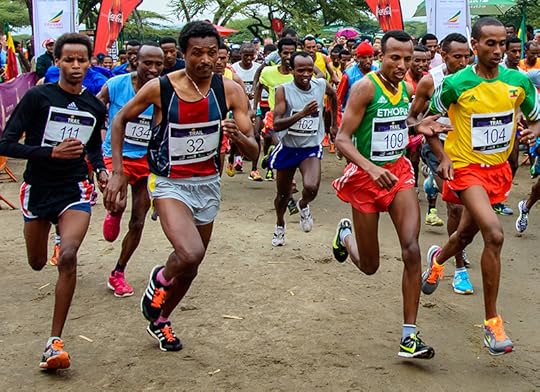
Ethiopia's Ethiotrail Races
The opportunity to win 10,000 Birr proved to be a strong motivator for runners, and the pace at the start was more like a road race than a typical trail race found in the U.S. Photo: Peter N. Jones
View Larger Image
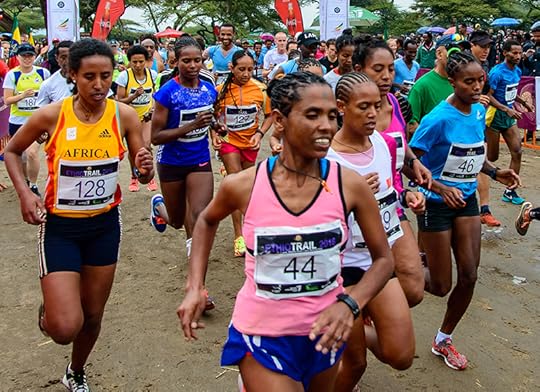
Ethiopia's Ethiotrail Races
The race provided the same prize purse to women runners as for men, attracting a strong women's field of fast runners aiming to take home the prize. Photo: Peter N. Jones
View Larger Image
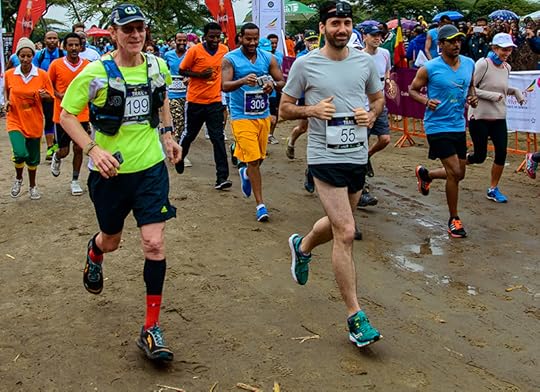
Ethiopia's Ethiotrail Races
With runners from more than 20 countries at the event, including South Africa, Australia, Germany, Denmark, United States, Saudi Arabia, Japan, Spain, and beyond, the race had a competitive yet festive atmosphere that welcomed runners of all abilities and nationalities. Photo: Peter N. Jones
View Larger Image
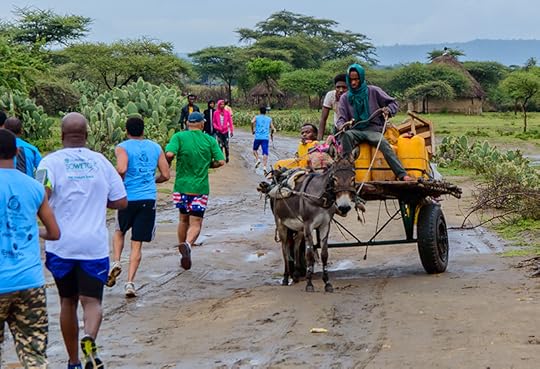
Ethiopia's Ethiotrail Races
Running through small Oromo tribal villages was one of the highlights of the course, but it also presented obstacles such as here, where runners had to go around a typical donkey and cart carrying drinkable water from the well to the village. Photo: Peter N. Jones
View Larger Image

Ethiopia's Ethiotrail Races
South African runner Steve Granger ran up one of the many short but steep ravines that the course crosses. The course undulated through the National Park across numerous ravines, as well as climbing two volcanoes and traversing the shores of Lake Shalla. Photo: Peter N. Jones
View Larger Image

Ethiopia's Ethiotrail Races
Runners quickly spread out along the course as it passed through Oromo tribal villages and farmland. Photo: Peter N. Jones
View Larger Image
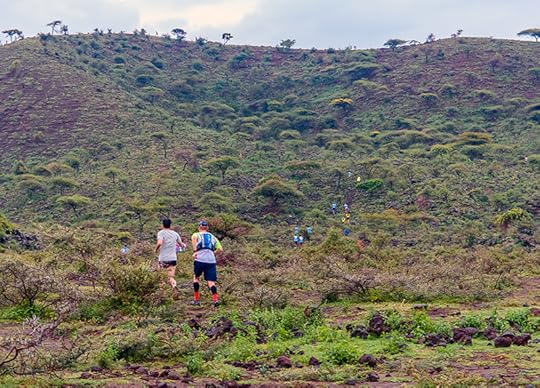
Ethiopia's Ethiotrail Races
Runners had to climb up the side of this ancient volcano, along a rocky off-trail section that led to a spectacular ridge traverse and expansive view of the Rift Valley below. Photo: Peter N. Jones
View Larger Image
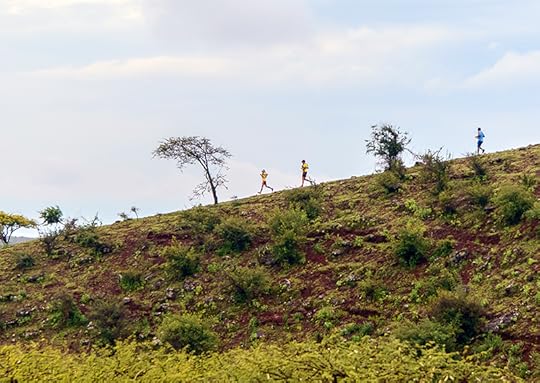
Ethiopia's Ethiotrail Races
A large part of the course was off-trail, marked simply with red ribbons hanging from the Acacia trees. Here runners hammer down one of the ridges from the top of an ancient volcano back to the Rift Valley floor. Photo: Peter N. Jones
View Larger Image

Ethiopia's Ethiotrail Races
With expansive views in all directions, the course proved to be both technical but aesthetically pleasing as runners had the opportunity to run through parts of the National Park normally not accessible. Photo: Peter N. Jones
View Larger Image
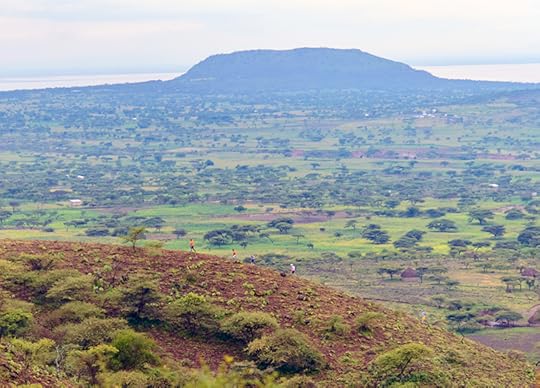
Ethiopia's Ethiotrail Races
After running up to the top of one volcano, runners then descended down back to the valley floor before running along the shores of Shalla Lake and ascending the small volcano in the distance. Photo: Peter N. Jones
View Larger Image
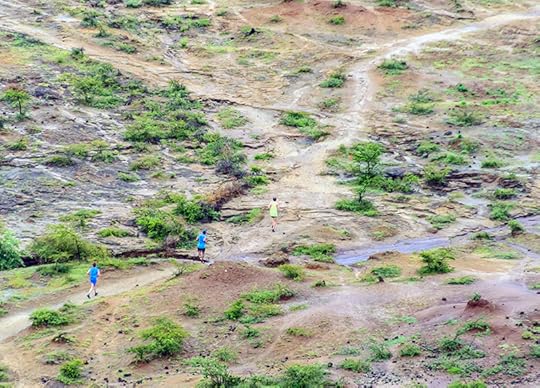
Ethiopia's Ethiotrail Races
Parts of the course traversed ancient flood plains and river beds, taking runners through landscapes that are similar to the landscapes the first humans ever ran across. “Lucy,” perhaps the most famous hominin skeleton ever found, was recovered in 1974 at a site less than 50 miles from the race course. Photo: Peter N. Jones
View Larger Image
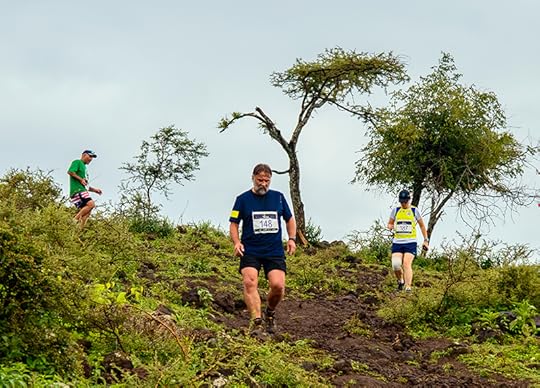
Ethiopia's Ethiotrail Races
The steep, rocky sides of the volcanoes required expert footing as runners had to watch their footing on the slick, razor sharp rocks. Photo: Peter N. Jones
View Larger Image
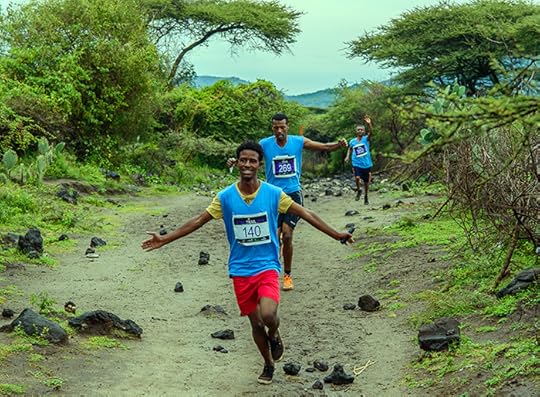
Ethiopia's Ethiotrail Races
Many of the Ethiopian runners lacked proper running gear, yet were able to cover the course with a smile while running in sandals, or low-tops as in this case. Photo: Peter N. Jones
View Larger Image
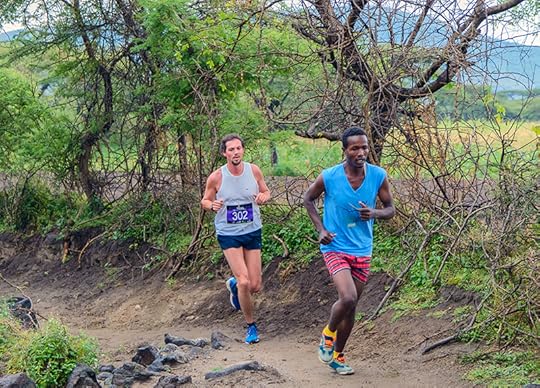
Ethiopia's Ethiotrail Races
Despite not speaking the same language, runners shared the course and some miles with each other, bringing a communal, festive vibe to the race. Photo: Peter N. Jones
View Larger Image
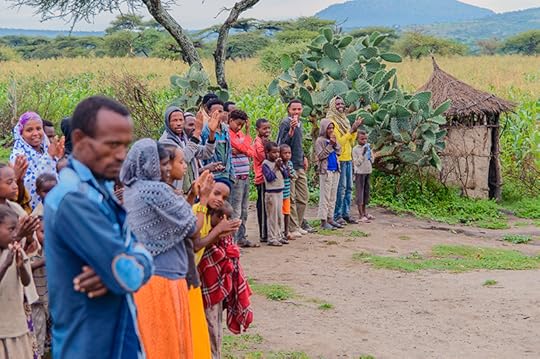
Ethiopia's Ethiotrail Races
All along the course Oromo villagers came out to watch and cheer on the runners. Photo: Peter N. Jones
View Larger Image
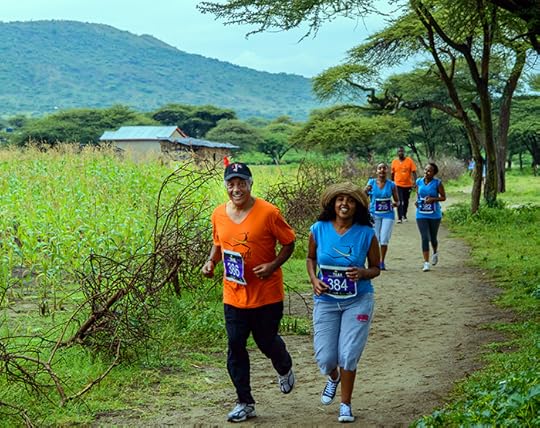
Ethiopia's Ethiotrail Races
In Ethiopia, everyone runs, from the young to the old, fast to the slow. Running is part of Ethiopian culture, and sharing a few miles with friends brings a smile to everyone's face. Photo: Peter N. Jones
View Larger Image
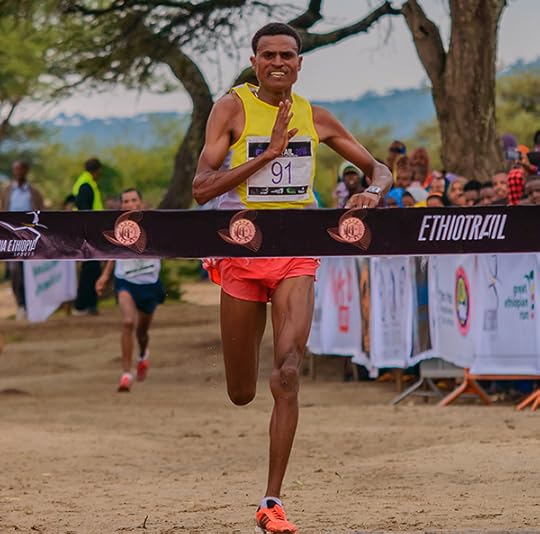
Ethiopia's Ethiotrail Races
Ethiopian elite runner Ifa Belda came away with the win, with a time of 1:16:52 on the technical course. Photo: Peter N. Jones
View Larger Image
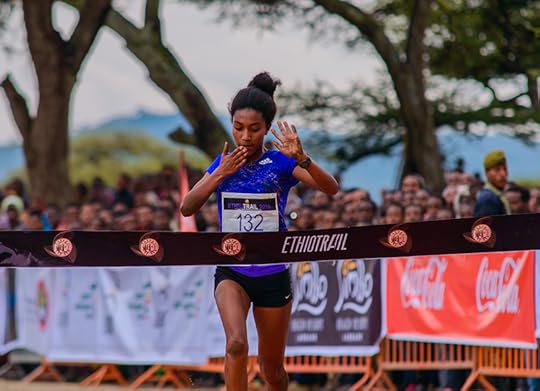
Ethiopia's Ethiotrail Races
Likna Ambaw was the women's winner with a time of 1:28:47. Many runners came across the finish line covered in mud from slipping on the technical descents of the volcanoes. Photo: Peter N. Jones
View Larger Image
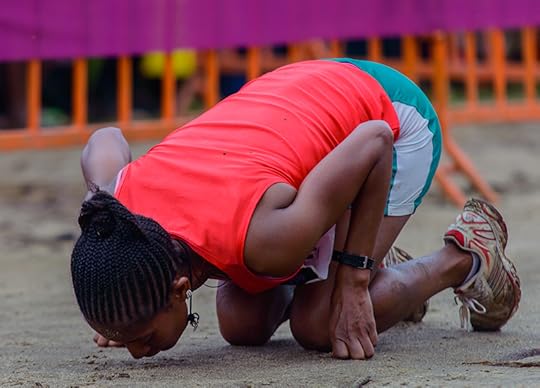
Ethiopia's Ethiotrail Races
Offering thanks for completing the run was common among all runners. The ancient Rift Valley has been home to humankind for over 5 million years, and honoring that long legacy of respect for the land and what it provides was common among all runners. Photo: Peter N. Jones

More Galleries
The post Running Deep in the Heart of Ethiopia’s Rift Valley appeared first on Competitor.com.
The North Face Takes a Stand Against Doping in Trail Running
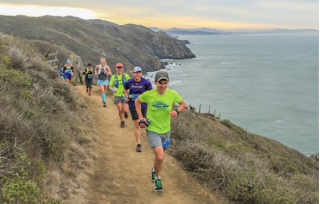
The North Face Endurance Challenge Series 50-mile championship race in the Marin Headlands near San Francisco is annually one of the most competitive trail races in the U.S.—due in part because it offers a $30,000 prize purse (including $10,000 for the winners). Photo: UltraRacePhotos
The North Face has taken a small but potentially very significant step to aid the movement against performance-enhancing drug use in endurance sports. As part of opening the elite registration for this year’s Endurance Challenge Championship 50-mile trail race on Dec. 3 in Mill Valley, Calif., The North Face today released a clean sport policy that it says will better ensure fair play across all of the Endurance Challenge Series (ECS) events in North America.
It comes on the heels of growing anti-doping sentiments coming out of the Rio Olympics. Also on Friday, the New York Times reported there are at least 120 athletes who have served suspensions competing in the Rio Olympics and 25 who have won medals in the past two weeks. Additional anti-doping efforts backed by elite athletes and big athletic brands are expected to be announced in the coming weeks.
Although it didn’t suggest it would start drug testing at its races, The North Face confirmed that it is committed to clean sport and does not condone the use of performance-enhancing drugs or banned substances at any level of competition. It also says it believes all athletes competing in the events put on by The North Face should educate themselves and abide by the anti-doping rules and banned substances established by the World Anti-Doping Agency (WADA).
Furthermore, it said athletes banned from competition by the International Association of Athletics Federations (IAAF) or WADA are prohibited from competing in any of its ECS events. Once an individual’s ban has been lifted, the athlete may participate in those events but will be forever ineligible to receive prize money, awards, podium recognition or overall age group competitive rankings at any distance, including the 50-mile elite field.
Last December, The North Face found itself in the middle of a firestorm when 33-year-old Italian runner Elisa Desco entered its 50-mile championship race. Desco, an accomplished and decorated athlete, won the 2009 World Mountain Running Championship in Campodolcino, Italy, only to be stripped of the title after testing positive for a form of the banned substance erythropoietin or EPO, a hormone that stimulates red blood cell production and improves endurance.
Because she had served a two-year suspension from 2010-2012, Desco was fully legal to compete again and had done well in numerous international trail races in the ensuing years. But dozens of elite and age-group ultrarunners, including Olympian-turned-elite-ultrarunner Magdalena Boulet, spoke out against her ability to enter The North Face race last year.
Performance-enhancing drugs are creeping into trail running and ultrarunning, but it’s not known how prevalent of a problem it is because there is almost no testing at those events. In July, the fifth-place finish of Ecuador’s Gonzalo Calistos was eliminated from the final results of 2015 Ultra-Trail du Mont-Blanc race in Europe after it was discovered he tested positive for using banned substances.
RELATED: Ultrarunning at a Crossroads: Is there a Growing Doping Problem on the Trails?
The North Face 50 annually has one of the richest prize purses in trail running, including a $10,000 cash payout for the winners. It was to be Desco’s first race in the U.S., where trail and ultrarunning are governed by U.S. Track & Field (as well as the IAAF and WADA), but there is no drug-testing protocol or budget for trail running races. (The American Trail Running Association has been investigating ways to implement drug testing at major U.S. trail races and has a preliminary system it could implement next year.)
Taking a stand and putting the new regulations in place not only gives The North Face the ability to keep dopers out of its race, but also discourages those who served bans from entering because there is no ability to win prizes or be recognized for finishing on the podium. Plus, it raises the awareness about PED use in trail running and shows that doping will not be tolerated, even without drug testing.
“We took our time to do this right. We did a lot of research and looked at a lot of data and we’re feeling pretty confident that it’s the right thing to do at the right time,” says Katie Ramage, Director of Sports Marketing for The North Face, who heads up the ECS series and The North Face elite athlete team. “Certainly it came to a head last year and it forced our hand to do something instead of talking about actually doing something. But we decided that we have a platform and a louder voice, but that platform is really about the community and we want to use it to be able to educate and to get educated by the community.”
RELATED: An Open Letter to Seb Coe To Ban Convicted Dopers for Life
The North Face is also providing educational resources and awareness about clean sport in trail running through a dedicated ECS Clean Sport website. The site will serve as a place for athletes, coaches, race directors, media and fans to better understand the facts, scientific research, opinions and other resources, including the full policy, code of ethics and educational materials for the Endurance Challenge Series.
In addition to the 50-mile championship near San Francisco, The North Face ECS events also have shorter races ranging from 10K to 50K and relay events to encourage all levels of runners the opportunity to participate. There are three events remaining on the ECS series schedule in 2016:
Sept. 17-18 – Kettle Moraine State Park, Eagle, Wisconsin
Sept. 24-25 – Park City Mountain Resort, Park City, Utah
Dec. 3-4 – Marin Headlands, near San Francisco
Several other U.S. races have put similar policies in place this year—led by Ian Sharman’s efforts at the U.S. SkyRunning Series—although many have taken it even further by permanently banning convicted dopers from their events even after their suspensions have been served. Also, numerous elite trail runners signed an ant-doping pledge last year at RunCleanGetDirty.org.
RELATED: The Effects of Performance-Enhancing Drugs on an Athlete
PHOTOS: Images from The North Face Endurance Challenge Series 2015 50-Mile Championship
The post The North Face Takes a Stand Against Doping in Trail Running appeared first on Competitor.com.
Old Guys Rule: Meb Keflezighi and Bernard Lagat are Olympians at 41
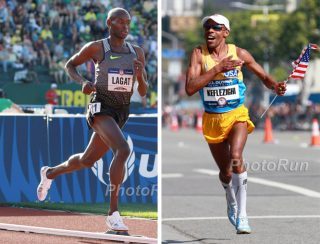
Veteran runners Bernard Lagat (left) and Meb Keflezighi—both 41 years old—hope to be in position to earn more Olympic medals this weekend in Rio de Janeiro. Photo: PhotoRun.net
It’s been a good Olympics for age and experience prevailing over youthful exuberance. From swimmer Michael Phelps (age 31) to cyclist Kristin Armstrong (she just turned 43), several Americans will exit the Games with gold medals in the twilights of their careers.
On the track, Usain Bolt’s remarkable streak of winning 100- and 200-meter sprints in three consecutive Olympics might earn him honorary old guy status, but the 29-year-old Bolt is still a baby compared to a pair of 41-year-old American runners, Meb Keflezighi and Bernard Lagat, who both hope to contend for medals in the final days of competition. Even if they don’t finish on the podium, their ability to remain fit and competitive on the world stage into their 40s has been impressive.
Keflezighi and Lagat bring formidable resumes to their races— Keflezighi will run the marathon on Sunday morning, while Lagat will contest the 5,000-meter race on Saturday evening after qualifying with a solid 13:26.02 effort in his semifinal heat on Wednesday.
RELATED: How to Watch Track & Field at the Rio Olympics on TV
The two men are already legends in the sport, but they can certainly cement their legacies with strong performances. Keflezighi earned the silver medal in the 2004 Olympic marathon and finished in fourth place in the 2012 Games at age 37. He also won the 2009 New York City Marathon and the 2014 Boston Marathon, among many other notable results. Lagat earned a bronze medal in the 2000 Olympic 1,500-meter race, then followed with a silver in that event in 2004. He’s stood on the podium in multiple world championships, competing in events at the 1,500, 3,000 and 5,000 meter distances, both indoors and outdoors. Lagat also placed fourth in the 2012 Olympics at age 37, just missing a bronze medal in the 5,000.
Both men immigrated to the U.S. from Africa: Keflezighi from Eritrea in 1975, Lagat from Kenya (the country he represented in his first two Olympics) in 2004. As a recent article in The New Yorker revealed, Keflezighi and Lagat share a scrupulous attitude about training for their events, and both display a joy for running that appears to be undiminished from their younger years. And a 2015 article in Competitor.com outlined the over-40 success of Keflezighi, Lagat and Deena Kastor.
The Olympics are not without a precedence of relatively older runners earning medals. In 2008, Constantina Diţă of Romania won the marathon in the Beijing Olympics, while Carlos Lopes of Portugal won the 1984 Olympic marathon in Los Angeles at age 37.
Keflezighi, a four-time Olympian, earned a spot on the U.S. team by finishing second at the U.S. Olympic Trials Marathon on Feb. 13 in Los Angeles, outrunning dozens of runners 10 to 15 years his junior. Lagat was equally impressive in earning his spot on the team, winning the 5,000-meter race at the U.S. Olympic Trials on the track on July 9 in Eugene, Ore. He closed with a furious 52.8-second final 400 meters to win the race and earn the chance to compete in his fifth Olympics—his third for the U.S. after two for his native Kenya.
RELATED: American Men to Watch in the Olympic Marathon
Neither is considered a clear medal favorite in their events—but it’s a safe bet that none of their competitors will be overlooking this pair of ageless athletes.
The post Old Guys Rule: Meb Keflezighi and Bernard Lagat are Olympians at 41 appeared first on Competitor.com.
August 18, 2016
Ancestral Athletes: American Runners Chase Olympic Dreams for Other Countries
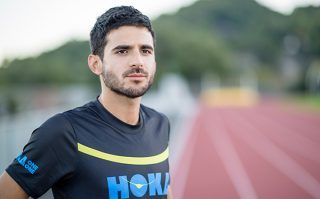
David Torrence
[Editor’s note: This story has been updated from the original version posted on July 1 to reflect Olympic results.]
David Torrence vividly remembers sitting on his grandmother’s porch in the Reseda neighborhood of Los Angeles with his sister and cousins after school when he was a kid in the mid-1990s. They’d do homework, eat picarones and sip Inca Kola while waiting for their parents to pick them up after work.
Picarones are a traditional Peruvian fried dough treat similar to a donut or a beignet that are made from pumpkin or squash and flour and served with a sweet syrup. Inca Kola is a gaudishly bright yellow soda from Peru with a lemony flavor that, he says, although available at some stores in the Los Angeles area, typically only Peruvian kids seemed to like.
“Some of my friends would come over and try it and the majority of them wouldn’t like it. It was a Peruvian thing,” Torrence, an elite American distance runner, recalls with a laugh. “As kids, we definitely all knew we were Peruvian—the Peruvian culture, the food, the language, the music was all around us at our homes and at family gatherings—and we were very proud of it.”
His mom, Bianca Torrence, grew up in Peru and emigrated to the U.S. in the 1990s with her parents and five siblings. As the family grew, they maintained their connection to the vibrant Peruvian community that was prevalent in the San Fernando Valley. (His dad, who died when David was 6, hailed from the U.S.)
“Everything we did as a family and the customs and attitudes of my family was all based in Peruvian culture,” Torrence recalls.
As he grew up in the Los Angeles suburb of Tarzana, though, Torrence, became a typical American kid. He liked American music, movies and sports teams, just like the rest of his friends. He ran cross country and track for Loyola High School in Los Angeles and improved enough during his senior year to run a 4:10 mile, win a few state titles and earn a scholarship to UC-Berkeley.
Since graduating from college in 2009, Torrence, who is 30, has emerged as one of the better middle-distance runners in the U.S. between 800 and 5,000 meters. Working under veteran U.S. coach John Cook, he’s continued to improve his times as a professional—including 3:52.01 in the mile and 13:16.53 for the 5,000. (After being backed by Nike for several years, he’s now sponsored by Hoka One One.) He’s also won four U.S. titles, set an American record in the 1,000-meter run indoors, helped the U.S. win a silver medal in the 4 x 1,500 relay at the IAAF World Relays in 2014 and earned a silver medal in the 5,000 while wearing a Team USA singlet in last summer’s Pan American Games in Toronto.
Like just about every elite distance runner, Torrence has dreamed of running in the Olympics since he was a teenager, and four years ago, he was so close he could taste it.
He ran smart and competitively to get through the prelims of the 1,500m at the 2012 U.S. Olympic Trials in Eugene, Ore. In the final—which was one of the deepest U.S. middle-distance race fields in decades—he was in contention with 150 meters to go. But his hard-charging sprint down the homestretch wasn’t quite fast enough and he finished a disappointing sixth—missing a chance to run in the London Olympics by three places and a mere 1.02 seconds.
It was a harsh reality that immediately relegated his Olympic dreams to a four-year hiatus.
But this time around, Torrence didn’t race in the July 1-10 U.S. Olympic Trials in Eugene, where the top three finishers earned a spot on the U.S. team bound for Rio de Janeiro. Instead, he’s competing in the Olympics for Peru—the country from which his mother’s side of the family hails—in the 5,000m.
“I’m very grateful for the opportunity to run for Peru, both to represent my family and the country,” Torrence says. “My family has been wanting me to do this for a very long time, both my family in the U.S. and in Peru. I first looked into it back in 2008, but I didn’t think it was the right opportunity for me at the time.”
Torrence is very familiar with the culture and the customs of Peru. He has visited there numerous times since he was a kid, including several post-collegiate, high-altitude training sessions over the past several years. He did a training stint there last fall while visiting family for the holidays and again recently while preparing for his 2016 outdoor track season.
Strangely enough, as the U.S. Olympic Trials got underway in Eugene, Torrence was the No. 2 ranked U.S. runner in the 1,500 (3;36.02) and the fourth-ranked runner in the 5,000m (13:19.4). But the U.S. has plenty of depth in that event, too, and, Peru doesn’t have any other runners who have surpassed the Olympic qualifying standard in the 800, 1,500 or 5,000.
Torrence, one of only about two dozen athletes competing for Peru in Rio, narrowly advanced to Saturday’s Olympic final in the 5,000m on Aug. 17 after running a 13:23.20—a new Peruvian national record. Although his time was faster than the winning time in the first heat, he was the last of the non-automatic qualifiers allowed into the final based on time.
The irony of Torrence’s situation—and perhaps a state of the modern Olympics—is that while Torrence will be competing in a Peruvian racing kit, two runners in the field—Bernard Lagat and Paul Chelimo—are Team USA competitors who were born in Kenya. Also, the pre-race favorite and defending champion is British runner Mo Farah, who is a native of Somalia.
“I think I would have had an excellent shot at making the U.S. team, but this is a decision I made and I’m happy with it,” Torrence said back in June. “Whoever makes the team for the U.S., it will be a competitive group. I was happy and proud to represent to the U.S. when I did, and now happy and proud to represent Peru, and hopefully be able to inspire some people there and maybe impact the running culture in a positive way, too.”
Torrence is one of a handful of U.S. distance runners competing for another country at this summer’s Olympics in Rio. Among the others are Colorado Springs-based marathoner Carlos Trujillo, who is representing Guatemala; Oregon’s Alexi Pappas, who placed 17th in the the 10,000-meter run while competing for Greece; and Oregon’s Aisha Praught, who placed 14th in the 3,000-meter steeplechase for Jamaica. (San Francisco’s Jorge Maravilla attempted to reach the 2:19:00 Olympic qualifying standard in the marathon on July 3 so he could run for El Salvador but came up just short.)
It’s not a new trend—it happens every four years in numerous Olympic sports. Each of these runners has a different story, but they’re unified with the intent of following the dream of running in the Olympics for a country that is tied to their family heritage.
“I feel so blessed to have the opportunity to run in the Olympics,” says Pappas, who is connected to Greece via her maternal grandmother who was born there. “It’s a dream come true.”
RELATED: Olympic Dreams Unfolding on and off the Silver Screen for Alexi Pappas
The post Ancestral Athletes: American Runners Chase Olympic Dreams for Other Countries appeared first on Competitor.com.
U.S. Women 4×100 Relay Team Gains Spot in Finals
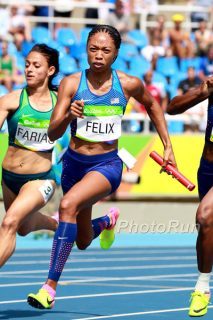
The United States women 4×100-meter squad has earned a place in the finals after they were granted a highly unusual opportunity to re-run its qualifying race.
On Thursday evening, they ran 41.77 seconds, good enough to best the Chinese team’s 42.70 mark—the slowest of the finals qualifiers—and replace them in the medal event.
The Americans dropped the baton during their first attempt on Thursday morning. The fumble occurred at the exchange between Allyson Felix and English Gardner—however, officials determined that Felix was interfered with by Brazil’s Kauiza Venancio, running in the lane next to the Americans.
Shortly after the fumble, Felix told Gardner to retrieve the bottom and finish the race, enabling the Americans to lodge a protest. Germany won the heat in 42.18 seconds; the Americans finished last.
Olympic officials faced a tough decision after the American appeal. With all the qualifying teams set for the finals, and only eight lanes available on the track, the determination was made to allow the Americans a chance to re-run the event by themselves.
After the successful time trial on Thursday evening, the U.S. squad will have a chance to medal on Saturday.
The post U.S. Women 4×100 Relay Team Gains Spot in Finals appeared first on Competitor.com.
U.S. Women 4×100 Relay Team Granted Re-Run Opportunity Tonight

The United States women 4×100-meter squad has been granted a highly unusual opportunity to re-run its qualifying race. The Americans dropped the baton during the exchange between Allyson Felix and English Gardner in this morning’s qualifying race. However, officials determined that Felix was interfered with by Brazil’s Kauiza Venancio, running in the lane next to the Americans.
You can watch the Americans re-run the 4X100 at 7 PM EST tonight on NBC.
Shortly after the fumble, Felix told Gardner to retrieve the bottom and finish the race, enabling the Americans to lodge a protest. Germany won the heat in 42.18 seconds; the Americans finished last.
When the U.S. protest was successful, Olympic officials faced a tough decision on how to proceed. With all the qualifying teams set for the finals, and only eight lanes available on the track, the determination was made to allow the Americans a chance to time-trial the event by themselves, in attempt to better the 42.70 time set by China and replace them in the final.
The post U.S. Women 4×100 Relay Team Granted Re-Run Opportunity Tonight appeared first on Competitor.com.
Pearl Izumi Exiting Running Category
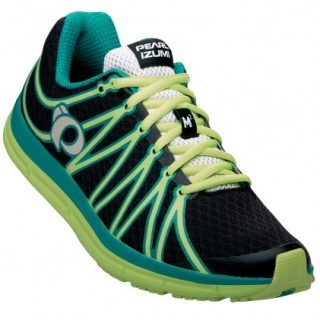
Pearl Izumi, a long-standing producer of athletic apparel and footwear, announced today that it will leave the running category and focus exclusively on cycling products in the road, mountain and triathlon disciplines. Pearl Izumi’s press release states that the decision reflects an “all in” commitment to its core interest in cycling.
Pearl Izumi’s running gear will be completely phased out by January of 2017. The company’s statement did not say if the decision is based on current trends in running or cycling participation. The non-profit Outdoor Industry Association’s most recent report shows flat to slightly declining participation in both road cycling and road running, though it also points to upward trends in off-road running, mountain biking and off-road triathlon.
Pearl Izumi USA, Inc., which is based in Louisville, Colo., is a subsidiary of Shimano America, Inc.
“Over the past 13 years, our Run team has designed award-winning product and gained a loyal consumer following. This is a tough decision, but it’s time to recommit to our core,” said Mike O’Connor, president of Pearl Izumi USA.
Read more from the Pearl Izumi press release.
The post Pearl Izumi Exiting Running Category appeared first on Competitor.com.
Ryan Hall's Blog
- Ryan Hall's profile
- 21 followers



